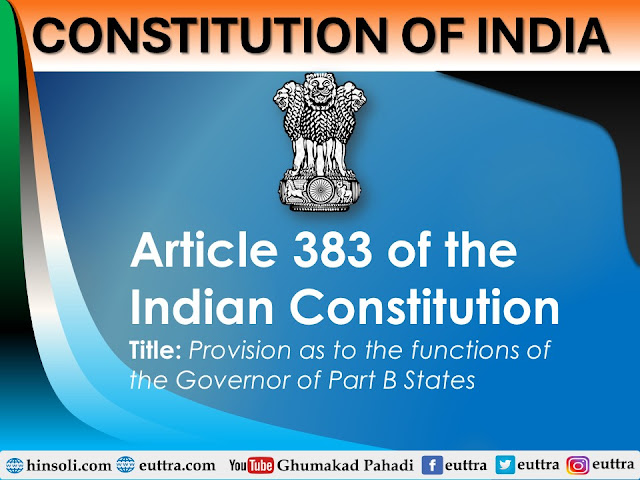 |
| What is Article 383 of Indian constitution |
Article 383 of the Indian Constitution
Title: Provision as to the functions of the Governor of Part B States
❗️Status:
Article 383 has been repealed.
It was a transitional provision, omitted by the Constitution (Seventh Amendment) Act, 1956.
🧾 Original Purpose (Before Repeal):
-
Article 383 dealt with the functions and powers of the Governor in Part B States after the Constitution came into force on 26 January 1950.
-
It provided that until the Legislature of a Part B State was constituted under the Constitution, the Governor would exercise legislative powers.
🔍 Simplified Explanation:
-
After the Constitution came into effect, Part B States (like Mysore, Rajasthan, etc.) didn’t have elected legislatures immediately.
-
So, Article 383 allowed the Governor (formerly the Rajpramukh) to exercise legislative powers.
-
This was a temporary arrangement until regular State Legislatures were formed through elections.
📌 Key Features:
| Aspect | Details |
|---|---|
| Applies To | Part B States |
| Subject | Governor’s legislative powers before Legislature is formed |
| Power Granted | Governor can make laws (by ordinance or order) in absence of legislature |
| Duration | Until the elected Legislature of the state is established |
| Repealed By | 7th Constitutional Amendment Act, 1956 |
🗂️ Background – What Were Part B States?
Part B States were mostly former princely states or unions of princely states such as:
-
Hyderabad
-
Mysore
-
Jammu & Kashmir
-
Madhya Bharat
-
Rajasthan
-
Travancore-Cochin
-
PEPSU (Patiala and East Punjab States Union)
✅ Why Article 383 Was Important (and Then Repealed):
-
Ensured governance continuity when no elected legislature existed.
-
Avoided a legislative vacuum in newly merged princely states.
-
Repealed after States Reorganisation Act, 1956, which ended the classification of states and established uniform governance provisions.

.jpg)



















Follow Us